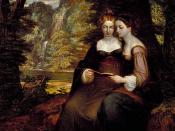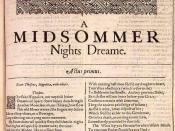Nowadays, people consider comedies to always be funny and happy-go-lucky, but true comedies aren't necessarily as simple as that. True comedies are much more complicated than the basic-plotted sit-coms we see on television. There are many elements to them and William Shakespeare seems to have mastered the art of comedy. Among the many comedies he has written, "A Midsummer Night's Dream" is definitely one of the least realistic, yet most entertaining of them all.
There is a basic outline and unities that comedies tend to follow: Off-stage action / long middle section / reconciliation Situation hostile confused identity love triumphs to love blockers in charge return to normalcy "A Midsummer Night's Dream" follows the preceding chart fairly well. This chart will be further explained in detail in chronological order.
As all comedies go, "A Midsummer Night's Dream" begins in the middle of a situation that is very hostile to love.
Hermia and Lysander are deeply in love with one another and wish to be married. Egeus, Hermia's father, wishes for Hermia to marry Demetrius who had once loved Hermia's best friend Helena. The dilemma is brought to the attention of Duke Theseus, who just happens to be getting married in a few days to Amazon queen, Hippolyta. Theseus states that by law Hermia must do what her father says or she will be punished by death or nunnery. The young lovers are devastated. Demetrius also has feelings for Hermia, thus forming a love triangle. The love triangle is escalated to an even higher level by adding the element of Helena obsessing over Demetrius.
The true lovers plot to escape to the forest where they will flee from there to wed. Helena tells Demetrius and they track the lovers into the woods. Fairy King Oberon is disgusted...


